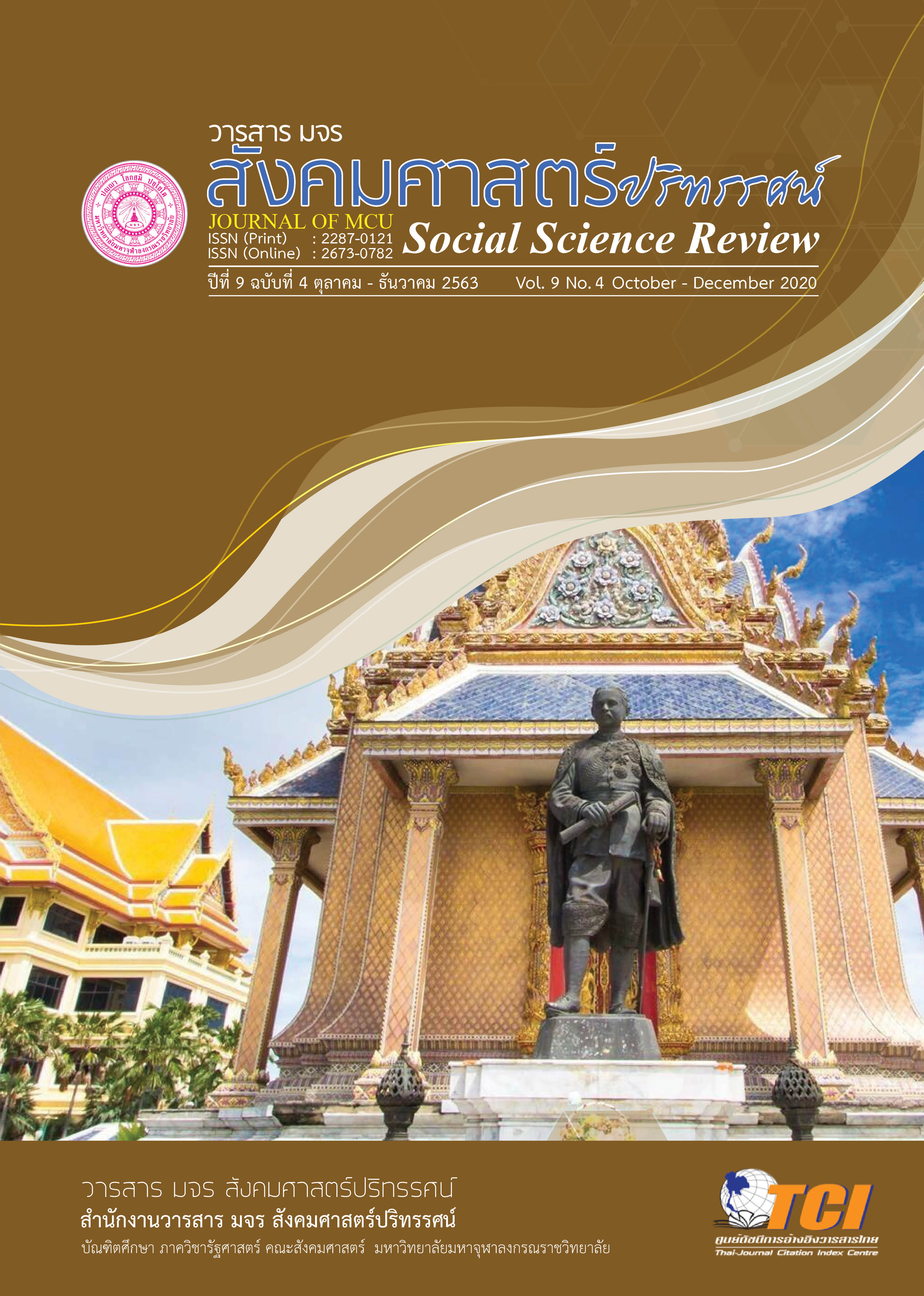การพัฒนาชุมชนตามหลักของพระชิตะกู ชยาดอ ญาณิสสาระ
คำสำคัญ:
การพัฒนา, ชุมชน, อิทธิบาท 4บทคัดย่อ
การวิจัยครั้งนี้มีวัตถุประสงค์เพื่อศึกษาสภาพทั่วไปของการพัฒนาชุมชนตามหลักของ Sitagu Sayadaw Nyãnissara, เพื่อศึกษาปัจจัยที่มีผลต่อการพัฒนาชุมชนตามหลักของ Sitagu Sayadaw Nyãnissara และเพื่อเสนอแนวทางปรับปรุงการพัฒนาชุมชนตามหลักของ Sitagu Sayadaw Nyãnissara การวิจัยเป็นแบบผสานวิธี การวิจัยเชิงคุณภาพโดยการสัมภาษณ์แบบเจาะลึกผู้ให้ข้อมูลสำคัญ 20 คน และสนทนากลุ่มกับผู้เชี่ยวชาญ 9 คน วิเคราะห์ข้อมูลโดยใช้เทคนิคการวิเคราะห์เชิงอุปนัย การวิจัยเชิงปริมาณเก็บข้อมูลด้วยแบบสอบถามที่มีค่าสัมประสิทธิ์ความเชื่อมั่นเท่ากับ 0.969 จากกลุ่มตัวอย่าง 280 คน สถิติที่ใช้คือ ความถี่ ร้อยละ ค่าเฉลี่ย และส่วนเบี่ยงเบนมาตรฐาน ผลการวิจัยพบว่า บริบททั่วไปของการศึกษาการพัฒนาชุมชนตามหลักของ Sitagu Sayadaw Nyãnissara โดยภาพรวมการพัฒนาชุมชนเป็นที่น่าพอใจในหลายปัจจัย อย่างไรก็ตาม มีหลายประเด็นที่จำเป็นต้องปรับปรุงผ่านความร่วมมือจากหลายส่วน ปัจจัยที่ส่งผลต่อการพัฒนาชุมชนมี 6 ขั้น คือ ด้านการวางแผนทั้งปัจจุบันและอนาคต ด้านการจัดการที่มีคุณค่าทางธุรกิจ ด้านบุคลากรต้องมีโครงการพัฒนาบุคลากร ด้านการกำกับมีการพัฒนาแผนรองรับความเสี่ยงทางธุรกิจ ด้านการประสานงานต้องมีความสัมพันธ์กับนานาประเทศและด้านการควบคุมต้องควบคุมในสิ่งที่สำคัญ และหลักอิทธิบาท 4 ได้แก่ ฉันทะคือความใฝ่ฝัน วิริยะคือความมุ่งมั่นในการพัฒนาชุมชน จิตตะคือความฝักใฝ่ต่อเป้าหมายที่ชัดเจนในการพัฒนาชุมชน และ วิมังสาเป็นการตรวจสอบในการพัฒนาชุมชน ส่วนแนวทางในการพัฒนาชุมชนเป็นเรื่องของรัฐบาลพม่า โดยให้ประชาชนในชุมชนมีส่วนร่วม, มีการร่วมมือกับองค์การระหว่างประเทศเพื่อนำไปสู่การพัฒนาชุมชนอย่างยั่งยืน
เอกสารอ้างอิง
Chhon, K. (2019). Life and Hope Association: Engaged Buddhist Strategy Transforming Compassion into Social Action. International Journal of Multidisciplinary in Management and Tourism, 3(2), 105-118.
Ministry of Foreign Affairs. (2016) Introduction of Myanmar. Retrieved March 20, 2016, from http://www.mofa.gov.mm/30/04/2016.
Patterns, W. F. (1996). Universities in early modern Europe, 1500-1800, a history of the university in Europe. England: Cambridge University Press.
Phrakhrupisitphachanat (Prayoon Nandiyo) et al. (2020). THE DEVELOPMENT OF THE MONKS’ PARTICIPATION IN COMMUNITY DEVELOPMENT ACCORDING TO BUDDHISM IN SAMUT SONGKHRAM PROVINCE. Journal of MCU Social Science Review, 9(1), 23-36.
Prasad, R. (2003). How Community Participation Can Integrate Energy Transitions Into Rural Development: The Experience of Four North Indian Villages. The Journal of Energy and Development, 28(2), 159-172.
Rerkrai, D. (1989). The Role of Buddhism in Rural Development of Thailand: Some Performances and Outcomes. Kasetsart Journal Social Science, 10(1), 87-102.
Thamsawana, V. (2020). Iddhipada 4 (Four Successful Paths). Retrieved March 20, 2020, from https://th-th.facebook.com/384124475003532/posts/iddhipada-4-four-successful-pathsIddhipada-means-path-of- accomplishment-or-basis-/385259094890070/30/05/2020.
Wannatong, P. (2018). The Application of Iddhipãda IV in Administrating Private Organizations in Nonthaburi Province. Journal of MCU Social Science Review, 7(2), 99-110.
World Bank. (2016). Myanmar and the World Bank, Reengaging through Community Driven Development, to Tackle Poverty in RuralVillages. Retrieved March 20, 2016, from http://www.worldbank.org/en/news/feature/24/02/2016.
ดาวน์โหลด
เผยแพร่แล้ว
รูปแบบการอ้างอิง
ฉบับ
ประเภทบทความ
สัญญาอนุญาต
ลิขสิทธิ์ (c) 2020 วารสาร มจร สังคมศาสตร์ปริทรรศน์

อนุญาตภายใต้เงื่อนไข Creative Commons Attribution-NonCommercial-NoDerivatives 4.0 International License.
เพื่อให้เป็นไปตามกฎหมายลิขสิทธิ์ ผู้นิพนธ์ทุกท่านต้องลงลายมือชื่อในแบบฟอร์มใบมอบลิขสิทธิ์บทความให้แก่วารสารฯ พร้อมกับบทความต้นฉบับที่ได้แก้ไขครั้งสุดท้าย นอกจากนี้ ผู้นิพนธ์ทุกท่านต้องยืนยันว่าบทความต้นฉบับที่ส่งมาตีพิมพ์นั้น ได้ส่งมาตีพิมพ์เฉพาะในวารสาร มจร สังคมศาสตร์ปริทรรศน์ เพียงแห่งเดียวเท่านั้น หากมีการใช้ภาพหรือตารางหรือเนื้อหาอื่นๆ ของผู้นิพนธ์อื่นที่ปรากฏในสิ่งตีพิมพ์อื่นมาแล้ว ผู้นิพนธ์ต้องขออนุญาตเจ้าของลิขสิทธิ์ก่อน พร้อมทั้งแสดงหนังสือที่ได้รับการยินยอมต่อบรรณาธิการ ก่อนที่บทความจะได้รับการตีพิมพ์ หากไม่เป็นไปตามข้อกำหนดเบื้องต้น ทางวารสารจะถอดบทความของท่านออกโดยไม่มีข้อยกเว้นใดๆ ทั้งสิ้น





